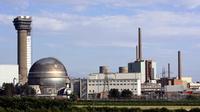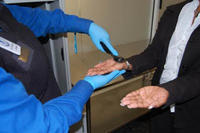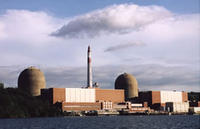-
U.K. awards 160 million Pound nuclear decommissioning contracts

The decommissioning of one of U.K. oldest nuclear plants — Sellafield, located close to the village of Seascale on the coast of the Irish Sea in Cumbria, England — has taken a giant step forward thanks to the awarding of three waste retrieval contracts worth more than 160 million Pounds
-
-
TSA could begin searching for explosives hidden inside you

Government intelligence officials are now warning airlines that terrorists could be using surgically implanted explosives to bypass security measures; there is no information regarding a specific plot or threat, but airlines could begin to implement additional screening procedures as the current body scanners cannot effectively detect bombs hidden inside an individual; last year, al Qaeda operatives in Iraq implanted two dogs with explosives, but the dogs died before they could loaded onto a U.S.-bound plane
-
-
Nano detector spots deadly anthrax
The average time of detection of an anthrax attack by current methods — the time required for DNA purification, combined with real-time polymerase chain reaction (PCR) analysis — is sixty minutes; a new, automatic, and portable detector takes just fifteen minutes to analyze a sample suspected of contamination with anthrax
-
-
45 percent of children in Fukushima exposed to thyroid radiation

A survey revealed that 45 percent of children living near the Fukushima Daiichi nuclear power plant have been exposed to thyroid radiation; following the nuclear disaster and the revelation that radiation was leaking from reactor no. 1, researchers tested more than 1,000 children from newborns to age fifteen in the Fukushima Prefecture; children were found to have been exposed to 0.04 microsievert per hour or less in most cases
-
-
New York governor determined to close Indian Point nuclear plant

The Indian Point nuclear power plant, located thirty-five miles north of New York City, is facing increasing pressure from Governor Andrew Cuomo and senior officials say the governor is determined to shut it down; the governor’s hand has been strengthened by new legislation that streamlines the approval process for siting new power plants in New York, a move that would make it easier to replace Indian Point; closing the nuclear plant would be a major step toward reshaping the state’s energy policy as the plant produces 2,000 megawatts and provides New York City and Westchester with 25 percent of their power — but the nuclear disaster in Japan caused by the 11 March earthquake and tsunami raised fresh concerns about the plant, which is located near a fault line
-
-
New airport scanner can detect liquid explosives
Passengers boarding airplanes could soon be walking through security checkpoints carrying liquids once more thanks to a high tech scanner capable of detecting liquid explosives; the device, developed by U.K. based Kromek, is capable of identifying dangerous liquids within seconds and does not require the container to be opened
-
-
Los Alamos nuclear waste safe from wildfire
A wildfire is raging near the Los Alamos national Lab; the fire, in some places, is only yards away from the lab’s outside perimeter — and it is eight miles from the so-called Area G; the Area G site is a 63-acre storage facility where thousands of drums of nuclear waste sit, many of which are outdoors started; the good news is that there is no danger that the fire will reach Area G because in 2000, an even more intense fire burned 90 percent of the forest that covered the area between the current fire and the nuclear waste disposal site, making it impossible for the current wild fire to reach the nuclear material on storage
-
-
Universal Detection to supply Singapore with biological detectors
Universal Detection Technology announced that earlier this week it had won a tender to supply Singapore’s Civil Defense Force with biological weapon detection equipment; under the deal Universal Detection, a developer of early-warning monitoring technologies, will provide equipment capable of detecting biological agents like Anthrax, Ricin, Botulinum, Plague, and Tularemia
-
-
Documents reveal TSA ignored dangers of body scanners
The Electronic Privacy Information Center (EPIC) says that is has official documents that reveal the Transportation Security Administration (TSA) deliberately ignored warnings that airport body scanners pose a health risk; the internal documents and email exchanges show that TSA officials brushed aside concerns that employees raised after noticing that a large number of workers had cancer, strokes, and heart disease after working near the body scanners
-
-
Nanowire-based sensors detect volatile organic compounds
Researchers have made nano-sized sensors that detect volatile organic compounds — harmful pollutants released from paints, cleaners, pesticides, and other products — which offer several advantages over today’s commercial gas sensors, including low-power room-temperature operation and the ability to detect one or several compounds over a wide range of concentrations
-
-
Sector Report for Monday, 20 June 2011: Detection
This report contains the following stories.
Plus 1 additional story.
-
-
Navy funds development of new explosives detection technology
The Navy recently awarded researchers at Texas Tech University a four year $1.2 million grant to develop a more effective method to detect explosive materials; the project is spearheaded by four Texas Tech professors specializing in chemical engineering; one professor explained, “In layman’s terms, basically we’re trying to enhance detection for explosives”
-
-
DHS tests three radiation detection systems at Belmont Stakes race
DHS officials recently announced that it had tested three developmental systems designed to detect radiological weapons at the Belmont Stakes horse race in New York held on Saturday, 11 June; DHS tested two mobile Stand-Off Radiation Detection Systems; the third device tested was a Roadside tracker which scans for radiation sources in vehicles
-
-
Exigent helps Navy hospital monitor radiation
Last week Exigent Security Products announced that it will supply a large amount of radiation detection systems to the National Naval Medical Center in Bethesda, Maryland; the latest shipment is the third order from the Navy medical center and is for the company’s Radiation Detection Area Monitors which will be used to monitor radioactive materials used to treat patients
-
-
Mud triggers Logan alarm
Scanning machines at Logan Airport detected minute traces of nitrates in a checked luggage, and sounded the alarm; two gates were evacuated as a precaution; police found that the nitrates emanated from mud sample a Honk Kong University doctoral student was carrying in the luggage; the samples were to be used in research
-